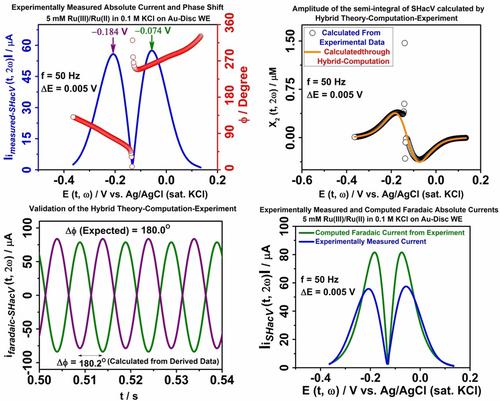当前位置:
X-MOL 学术
›
Electroanalysis
›
论文详情
Our official English website, www.x-mol.net, welcomes your feedback! (Note: you will need to create a separate account there.)
Advantage of Fractional Calculus Based Hybrid‐Theoretical‐Computational‐Experimental Approach for Alternating Current Voltammetry
Electroanalysis ( IF 3 ) Pub Date : 2020-03-03 , DOI: 10.1002/elan.201900552 Saurav K. Guin 1 , Arvind S. Ambolikar 1, 2 , Shantanu Das 3 , Ashwini K. Poswal 4
Electroanalysis ( IF 3 ) Pub Date : 2020-03-03 , DOI: 10.1002/elan.201900552 Saurav K. Guin 1 , Arvind S. Ambolikar 1, 2 , Shantanu Das 3 , Ashwini K. Poswal 4
Affiliation

|
The dynamic electrochemical behavior of electroactive species is believed to be represented better by the fractional calculus, because it can consider the history of mass‐transfers of that species near the electrode surface. The elucidation of mathematical fundamentals of fractional calculus has been recently introduced for batteries, supercapacitors and a few voltammetry studies. The working equations for faradaic fundamental and second‐harmonic (SHac) components of alternating current (ac) for ac voltammetry of an electrochemically reversible redox reaction on an electrode of macroscopic diameter have been derived here by using generalized formulae of the fractional calculus. A computation code is written in Python language with a matrix based algorithm developed based on latest, accurate, efficient and stable Grunwald‐Letnikov‐Improved fractional‐order differentiation equation. That computational code is used to find the concealed faradaic fundamental, SHac components of the total current and other double‐layer parameters of experimentally recorded voltammograms of ruthenium(III/II) redox reaction on gold‐disc electrode by a common electrochemical workstation without having inbuilt Fourier transformation features. The amplitude of the computed faradaic current concealed in the experimental data gets enhanced through this hybrid theoretical‐computational‐experimental approach and thus it keeps scope of application and further improvement in electroanalysis.
中文翻译:

基于分数微积分的混合理论计算实验方法在交流伏安法中的优势
电活性物质的动态电化学行为被认为可以更好地表示为分数演算,因为它可以考虑该物质在电极表面附近的质量转移历史。最近,已经针对电池,超级电容器和一些伏安法研究引入了分数微积分的数学原理的阐明。在此,通过使用分数演算的通用公式,推导了交流电(ac)的法拉第基波和二次谐波(SHac)分量的工作方程,该交流电用于在大直径电极上进行电化学可逆氧化还原反应的交流伏安法。使用Python语言编写的计算代码,以及基于最新,准确,高效稳定的Grunwald-Letnikov-改进的分数阶微分方程。该计算代码用于通过通用电化学工作站在没有内置电极的情况下找到金圆盘电极上钌(III / II)氧化还原反应的实验记录的伏安图的总电流的隐藏法拉第基础,总电流的SHac分量以及其他双层参数傅立叶变换特征。通过这种混合的理论-计算-实验方法,隐藏在实验数据中的法拉第电流的幅度得到了增强,因此保留了其应用范围并在电分析领域进一步改进。通用电化学工作站在没有内置傅里叶变换特征的情况下,通过金记录的金-盘电极上钌(III / II)氧化还原反应的伏安图的实验记录的伏安图的总电流和其他双层参数的SHac分量。通过这种混合的理论-计算-实验方法,隐藏在实验数据中的法拉第电流的幅度得到了增强,因此保留了其应用范围并在电分析领域进一步改进。通用电化学工作站在没有内置傅里叶变换特征的情况下,通过金记录的金-盘电极上钌(III / II)氧化还原反应的伏安图的实验记录的伏安图的总电流和其他双层参数的SHac分量。通过这种混合的理论-计算-实验方法,隐藏在实验数据中的法拉第电流的幅度得到了增强,因此保留了其应用范围并在电分析领域进一步改进。
更新日期:2020-03-03
中文翻译:

基于分数微积分的混合理论计算实验方法在交流伏安法中的优势
电活性物质的动态电化学行为被认为可以更好地表示为分数演算,因为它可以考虑该物质在电极表面附近的质量转移历史。最近,已经针对电池,超级电容器和一些伏安法研究引入了分数微积分的数学原理的阐明。在此,通过使用分数演算的通用公式,推导了交流电(ac)的法拉第基波和二次谐波(SHac)分量的工作方程,该交流电用于在大直径电极上进行电化学可逆氧化还原反应的交流伏安法。使用Python语言编写的计算代码,以及基于最新,准确,高效稳定的Grunwald-Letnikov-改进的分数阶微分方程。该计算代码用于通过通用电化学工作站在没有内置电极的情况下找到金圆盘电极上钌(III / II)氧化还原反应的实验记录的伏安图的总电流的隐藏法拉第基础,总电流的SHac分量以及其他双层参数傅立叶变换特征。通过这种混合的理论-计算-实验方法,隐藏在实验数据中的法拉第电流的幅度得到了增强,因此保留了其应用范围并在电分析领域进一步改进。通用电化学工作站在没有内置傅里叶变换特征的情况下,通过金记录的金-盘电极上钌(III / II)氧化还原反应的伏安图的实验记录的伏安图的总电流和其他双层参数的SHac分量。通过这种混合的理论-计算-实验方法,隐藏在实验数据中的法拉第电流的幅度得到了增强,因此保留了其应用范围并在电分析领域进一步改进。通用电化学工作站在没有内置傅里叶变换特征的情况下,通过金记录的金-盘电极上钌(III / II)氧化还原反应的伏安图的实验记录的伏安图的总电流和其他双层参数的SHac分量。通过这种混合的理论-计算-实验方法,隐藏在实验数据中的法拉第电流的幅度得到了增强,因此保留了其应用范围并在电分析领域进一步改进。


























 京公网安备 11010802027423号
京公网安备 11010802027423号